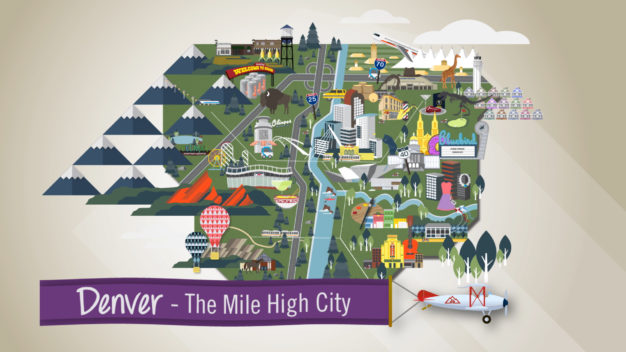Run & Gun – You may have heard the term when talking basketball or perhaps in reference to those shoot em’ up video games, but run & gun also refers to a type of filmmaking. It’s used to describe productions where you’re literally on the move, capturing footage as you go, oftentimes with minimal crew. The production could be anything from documentary to live event or conference.
What may surprise you about this type of production is, despite being impromptu in nature, a run and gun production actually involves a lot of planning. You have to be prepared for whatever unfolds during filming and you also need to be ready to adapt to changing plans.
 We do run and gun style filming for a few of our clients, but most commonly with Visit Denver – the city’s tourism office. Back in May we covered the international IPW conference that came to the city. And most recently we wrapped up a series of neighborhood spotlights and submarket videos of Denver.
We do run and gun style filming for a few of our clients, but most commonly with Visit Denver – the city’s tourism office. Back in May we covered the international IPW conference that came to the city. And most recently we wrapped up a series of neighborhood spotlights and submarket videos of Denver.
Along the way, I’ve learned some tips about run & gun. Though this is in no way a complete list nor does it apply to all types of this style of filmmaking, I think these 5 pieces of advice are a solid jumping off point for producing this type of video.
Be Organized
If you don’t know me, making spreadsheets, shot lists, and schedules are some of my favorite things to do (it’s ok, most of my friends don’t get me either). When capturing the IPW conference for Visit Denver, I had to lay out when and where certain conference events were happening in order to make sure we dispersed our crew appropriately. I even created a shot list of “must haves” and “nice to haves” to help prioritize what we were capturing at each location. Organization is key in ensuring you capture everything you need to make your final product.
Hope for the Best, But Plan For The Worst
As much as you want your production to go well, assume it won’t and use that to guide your plan A and plan B, C, D, etc. At IPW, half the events were outside in May and rain was in the forecast. I made sure to note which events had indoor back-up plans and where those back-up locations were located. Always having a plan B in your pocket will help shoot day run smoothly, no matter the situation.
Don’t Be Too Organized
“Huh? I thought you said be organized?” Yes, but as organized as you want to be, also be flexible. If something changes from your originally scheduled programming day of, you have to be ready to adapt. Leaving buffer times in your schedule can really help when plans go awry.
 Secure Permissions and Permits Well in Advance
Secure Permissions and Permits Well in Advance
Though we live in a time when you can order something on Amazon and have it delivered same day, it can still take 2-3 weeks to process a location permit. We ran into this a lot when securing permissions with the city of Denver and other similar entities. Keep this timing in mind as you go through pre-pro for your production.
In almost all cases, some sort of communication or agreement needs to happen between you and a location before you show up with your crew and a bunch of camera equipment. Don’t skip this step!
Have All Your Paperwork in Order and On Hand
You don’t know how many times I’ve stepped on to a location to film (even if only for 15 minutes) and was immediately approached by security. This happened at a few different locations when we were filming the neighborhood videos for Visit Denver. Even though you secured permits ahead of time with a manager, don’t assume the memo trickled down to the rest of the staff. Always make sure to have printed copies of any permissions on hand, even if it’s just an email from the location contact. That way you can show the person on site. I find having physical copies saves a lot of time, hassle, and confusion on site.
No production is perfect, but having the necessary tools and knowledge ahead of time will help any run and gun style production stay on track, no matter how fast and furious it is day of.
And when all else fails, contact us at One Floor Up. We’ve done a few of these before.

